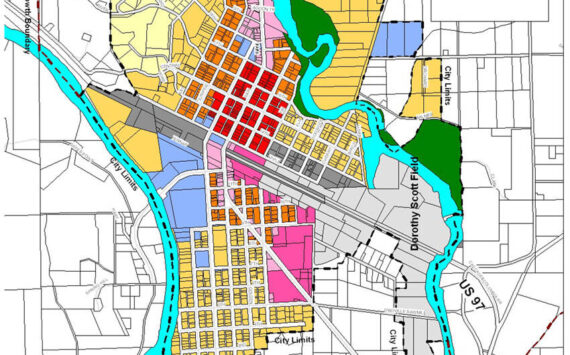Several scenarios to be considered
TONASKET – This past year has seen a mix of the good and the bad for North Valley Hospital’s financial condition.
On the positive side, the hospitals’ registered warrants (money it owes Okanogan County) have been reduced from nearly $3 million in August, 2012 to about $300,000 at one point, and stood at $595,000 at the time of the Thursday, Oct. 31, meeting of the Board of Commissioner. And the second floor surgical center opened just last month.
But much of that progress was painful, with the expense paid in layoffs in late 2012, closure of the Assisted Living facility and the closure of the Oroville and Tonasket clinics.
The next year will bring forth its own set of challenges, including the unpredictable effects of the Affordable Care Act (Obamacare), reduced Medicare reimbursement rates, the possibility of losing its status as a Critical Access Hospital (see accompanying article) and projected financial losses in the Long Term Care division that could be made worse by those uncertainties.
Chief Financial Officer Helen Verhasselt, in building a budget for 2014 explained the issues to the board and offered multiple budget scenarios for their consideration.
“I ran multiple scenarios to try to figure out how we could break even,” Verhasselt said. “Once I ran out of those, the next thing I focused on was how we could minimize the losses.”
Verhasselt said she based next year’s budgeting on this year’s patient volumes. She also asked the commissioners to approve a five percent rate hike (in the hospital division only), as there had not been one since 2010.
“On the Extended Care side this budget is looking at an average of about 48 Medicaid patients, three Medicares, and four private pays. We are not asking to do a price increase there.”
In fact, Verhasselt proposed giving a 10 percent discount for those who paid their bills in short order, such as by the end of the month of the billing.
“We’ve been facing some challenges trying to increase the private pays on the Extended Care side,” she said. “A lot of it is due to, people cannot afford about $7,000 a month private pay.”
Admitting some patients into hospital swing beds, rather than to Extended Care, dramatically increases the hospital’s reimbursements as well.
In those scenario, the best Verhasselt said she found was a $562,000 profit in the hospital division, with Long Term Care losing $520,000, for a net $42,000 profit.
That number sent Verhasselt looking for other options, she said.
“We can’t survive with that kind of profit,” said CEO Linda Michel. “We have to see the hundreds of thousands.”
“For one thing, we need to do that if we’re going to get the rest of the way out of warrants,” Verhasselt said.
The other scenario Verhasselt proposed involved two major changes that significantly cut into the LTC losses, she said.
The first piece of that involves changing the way expenses are accounted for between the hospital and Long Term Care divisions.
“What I have gotten approved by our cost report preparers is to change the allocation method. It still needs to be approved by Medicare but they think the scenario is acceptable.
If the therapist is seeing patients on the extended care side, on their time sheet they would put how may hours they put on extended care. Those wages would be charged to extended care rather than the cost of the service. We would be keeping the rest of the expense on the hospital side, it would help the reimbursement rate in the therapy department and would reduce the expenses substantially on the extended care side.”
The other piece of the proposal involved gradually reducing the capacity of the Extended Care to 40 (from the current 58) beds in an effort trim the divisions losses.
“The reason we looked at 40 beds is we looked at some other facilities that have made a 40 bed facility profitable,” Verhasselt said. “This would still be the same number of private pays in this budget as in the first scenario, and the same number of Medicares. It would reduce the number of Medicaid beds
“It could potentially be better results if we draw more private pays, but I didn’t want to do an aggressive number there. The bottom line would reduce the net loss (of Long Term Care) to $178,000. We would have a net income (for the whole district) of $341,000.”
Commissioner Clarice Nelson asked how reducing the number of beds could bring in more privately insured patients.
“Right now we only have two private rooms,” Verhaselt said. “It would give us the opportunity to have more private rooms instead of double occupancy in the majority of our rooms.
“We can do a revised budget at any point if the direction changes. The number of beds isn’t cast in stone either.”
“This could all change,” said commissioner Dick Larson. “I remember when the nursing home rates and the hospital occupancy was low – this thing had 70 patients all the time and the rate was such that it made up for the shortfall in the hospital. That can change rather quickly.”
“We have a proposal we could potentially move forward,” Duncan said. “In three months we could make a revision based on an evaluation of the performance at the end of the year.
“I have concerns about lowering our capacity to serve the community, but we have to have capacity to serve the community.”
The board asked Verhasselt to complete the details on a budget that involved working toward the 40-bed capacity in the Extended Care, while also submitting one that included only the changes in expense allocation between the two divisions.
“Changing the rehab inter-division allocation would put us somewhere between the first and second scenarios,” Verhasselt said. “I was looking at ways to try to minimize the losses. This seemed like one of the better ones.”
The board formally approved the five percent rate hike for the hospital division later in the meeting.
The budget will be submitted for final approval at the Thursday, Nov. 14 Board of Commissioners meeting.
New boiler up and running
When one of the hospital’s boilers went down for the count last spring, the race was on to get it replaced before cold weather set in.
Kelly Cariker, facilities director, declared that race won as the replacement was in its final stages of testing and had been up and running for about a day. The new boiler can run on either propane or diesel, and while propane would have been preferred, for the time being space considerations dictated the use of diesel fuel.
“We currently have the (other) diesel boilers and a diesel generator,” Cariker said. “Due to building space we could not add more propane and keep the diesel there (at this time). As we move forward and use less diesel we could explore that…. Diesel wasn’t our first choice, but with Phase I we were kind of locked in for now.”
The rest of the aging boilers will eventually need to be replaced as well, but Cariker said Phase I of the boiler replacement project was complete.
“If we move forward with any of the other phases (such as the geothermal system discussed at previous meetings), anything else we do, we’ll need to be receiving grant funding or PUD subsidies before we go forward. The new boiler is not geothermal… this phase, we replaced like equipment with like equipment, though we do have more capacity with BTUs out of this one than we did with the one before it.”
“If we can get some numbers and get started on the grant writing now, normally a project that size you need to do some advance grant writing,” Duncan said. “Even a Community Development Block Grant has a planning-only grant to help you pay for the planning part of it. That could allocate between $15-40,000 to help us with that planning process.
“I’ve been seeing more of the big foundations coming out with some bigger grants, as well,” she added.
The Board of Commissioners next meets on Thursday, Nov. 14, for its public hearing to finalize the 2014 budget.




